A Review on Detection and Treatment Methods of Sleep Apnea
Rajeswari Jayaraj1, Jagannath Mohan2, Adalarasu Kanagasabai3
1 Research Associate, School of Electronics Engineering, VIT University, Chennai, Tamil Nadu, India.
2 Associate Professor, School of Electronics Engineering, VIT University, Chennai, Tamil Nadu, India.
3 Professor, Department of Electronics and Communication Engineering, PSNA College of Engineering and Technology, Dindigul, Tamil Nadu, India.
NAME, ADDRESS, E-MAIL ID OF THE CORRESPONDING AUTHOR: Dr. Jagannath Mohan, Associate Professor, School of Electronics Engineering, VIT University, Chennai, Tamil Nadu, India.
E-mail: jagan.faith@gmail.com
This paper presents a review on detection and treatment methods of sleep apnea. Sleep apnea is the most common type of breathing-related sleep disorder. It manifests in a variety of behaviours from teeth grinding to night terrors as involuntary night-time events. The most common sleep disorders are narcolepsy, hypersomnia, sleep talking, sleep walking, and bedwetting. Sleep apnea (somnipathy) is a serious sleep disorder that pauses breathing while sleeping. Breathing pauses occur 30 times or more during sleep and it lasts for few divonds to minutes, when normal breathing starts after this pause. Untreated sleep apnea patients stop breathing, which happens up to hundreds of times during sleep that ultimately results in atrial fibrillation, cardiac arousal, stroke, brain tumor and other vascular diseases at the age of 65 that causes death. Smokers are at a greater threat for sleep apnea. Several studies have suggested that a person who smokes more than two packs a day has 40 times the risk of sleep apnea then nonsmokers. This review includes the discussion about detection of sleep apnea from heart rate and respiratory events. The published literature of sleep apnea and methods of treatment are also discussed.
Electrocardiogram,Heart rate analysis,Respiratory event
Introduction
Approximately 10% of middle aged grown-ups are affected by sleep-related breathing disorders [1]. According to morbidity and mortality, the breathing disorder is a serious risk factor because it has a long-standing effect on cardiovascular system. The sympathetic modulation and heart rate variability are closely associated with cardiac arrhythmia. The apnea and hypopnea are characterized by pauses in breathing for a period of 10 second during sleep. Sleep apnea can be classified into three types based on respiratory functions. The first type is Obstructive Sleep Apnea (OSA), it occurs when the patient stops breathing continuously, because of air lock in the upper airways and the second one is Central Sleep Apnea (CEN), which occurs during air lock in respiratory effort. Mixed Apnea (MIX), a third type, which is a combination of obstructive and central sleep apnea. This apnea is recognized by a lack of respiratory effort without air exchange due to upper airway obstruction.
Sleep apnea is detected by different methods and processes, different therapies are used to treat the apnea [2,3]. The present study reviews the following techniques for detection and treatment of sleep apnea:
Continuous Positive Airway Pressure (CPAP);
Automatic detection from single lead ECG;
Smart pillow system;
Micro-Electro Mechanical System (MEMS) sensor based device.
Discussion
A. Continuous Positive Airway Pressure (CPAP)
In 1981, Sullivan and others introduced a treatment method for sleep apnea syndrome that is nasal CPAP. CPAP device is used as a therapeutic technique for sleep apnea notably for OSA [4]. The automatic CPAP device has been commonly used for self-adjustment of the air pressure level based on the set point given by the user. The basic placement setting of a mask during sleep is depicted in [Table/Fig-1]. The automatic CPAP device is also developed for adapting the air pressure level when there is a change in the respiratory events during sleep [5]. The Automatic Positive Airway Pressure (APAP) device is used for supplying low airway pressure to patients and the pressure level is automatically adjusted based on the detection of sleep apnea event. [Table/Fig-2] shows the comparison of CPAP and APAP devices.
Placement of continuous positive airway pressure mask during sleep.
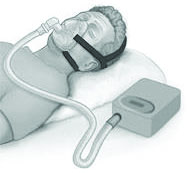
Comparison of continuous positive airway pressure (CPAP) and automatic positive airway pressure (APAP) devices.
| CPAP | APAP |
|---|
| Advantages | Limitations | Advantages | Limitations |
|---|
| Noninvasive | Increase of expiratory effort | Fluctuation between low and high level pressure on whole night and automatically adjusts the pressure level | APAP algorithm varies from one person to another |
| Immediate relief | Sense of forced air through the nostrils of the patient | Automatic elevation of pressure | During apnea events, sometimes the pressure change will be slow |
| Reduction of heart problems | Uniform maintenance of pressure level set by physician | Uniform maintenance of pressure level set by patient itself | More expensive |
B. Electrocardiogram (ECG) based Sleep Apnea Detection
Detection Module: There are two features used for detection of sleep apnea:
Standard deviation of the RR interval time series;
RR interval time series correlation coefficients.
Respiratory Module: Three states of the algorithms are used and compared to derive respiratory event from ECG through single lead:
ECG-Derived Respiration;
kernel Principal Component Analysis (kPCA);
PCA (Principal Component Analysis).
The features are taken as an input by the least-squares support vector machines classifier through the Radial Basis Function (RBF) kernel. Varon C et al., conducted a study which involved 80 ECG recordings for the detection of sleep apnea [6]. An 85% accuracy was obtained from data sets of independent apnea and hypopnea through minute-by-minute basis. Furthermore, 100% accuracy was obtained from the classification of apnea and non-apnea recordings. The methodology involved determination of ECG minute contamination level for apnea classification. The study result revealed that the ECG sensor yielded good accuracy in detecting sleep apnea [6]. Furthermore, artefacts were automatically detected by individual ECG segment contamination level. To entitle variations in morphology caused by a sympathetic activity during apnea, the components of QRS complexes were used. Orthogonal subspace projections were used to extract the details of heart rate and respiratory event [6].
Heart rate module: Respiratory sinus arrhythmia is a physiological mechanism that is used to calculate variations in heart rate. X and Y are the two physiological signals where X contains the RR time series and Y holds the respiratory information from thorax, abdomen using PCA and kPCA algorithms. The signal X is linearly related to Y and projected onto subspace V defined by variations in Y.
Varon C et al., investigated the performance of tested classifier, i.e., Support Vector Machine (SVM) and Linear Support Vector Machine (LSVM) under the condition of linear, polynomial and RBF kernel [6]. The parameter indices such as sensitivity, specificity, accuracy were considered. In the present article, the physionet dataset were considered from [6] and discussed with graphical representation [Table/Fig-3,4 and 5]. From this evaluation the RBF kernel performance is considered as prime and used for calculating the Apnea-Hypopnea Index (AHI). The AHI measures the apnea events in the value of 10 min/hour threshold from physionet dataset.
Performance measures for support vector machine (SVM) and least square support vector (LSVM) machine from linear condition [5].
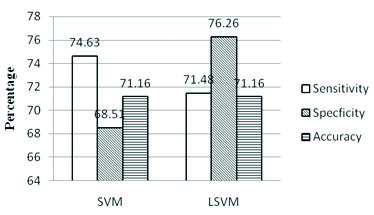
Performance measures for support vector machine (SVM) and least square support vector machine (LSVM) from polynomial condition [5].
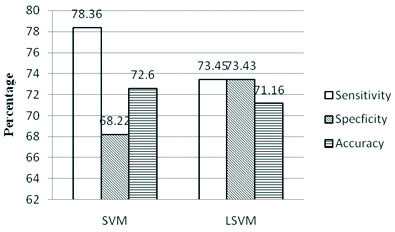
Performance measures for support vector machine (SVM) and least square support vector machine (LSVM) using radial basis function kernel [5].
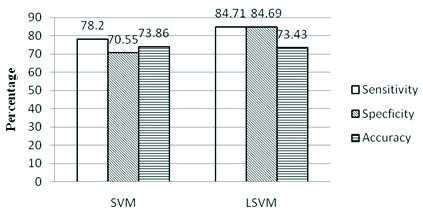
C. Auto-Adjustable Smart Pillow System
Event detection module: Automatic adjustable smart pillow system shown in [Table/Fig-6] is widely used for both detection and treatment of sleep apnea. A blood oxygen sensor is used for detecting sleep apnea events in real time. According to this device, the termination of sleep apnea event is adjusted automatically based on height and weight of the pillow. After adjustment, the blood oxygen signal is observed by sensor; because of the adjustment effectiveness, a suitable adjustment scheme can be identified.
Automatic adjustable smart pillow system.
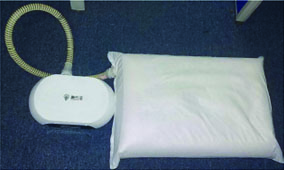
Event diagnosis module: This system is based on feedback control method and it is noninvasive, inexpensive and portable. A classification algorithm is used to make the decision on the pillow adjustment. To decide when and how to alter the pillow and how to estimate the effectiveness of the adjustment, a feedback pillow adjustment algorithm is used [7].
Functions of bladder: The pillow system shown in [Table/Fig-6] consists of five bladders inside, the biggest one lies first, followed by second bladder located at right side under the area of neck. On the left and right location of the pillow, the bladder three and four is placed and the fifth bladder is placed on the top of the user’s head. This system has air electrical pumps for inflation and deflation of the bladder using air pipe. The work flow of automatic adjustable pillow system is depicted in [Table/Fig-7].
Typical work flow of automatic adjustable smart pillow system.
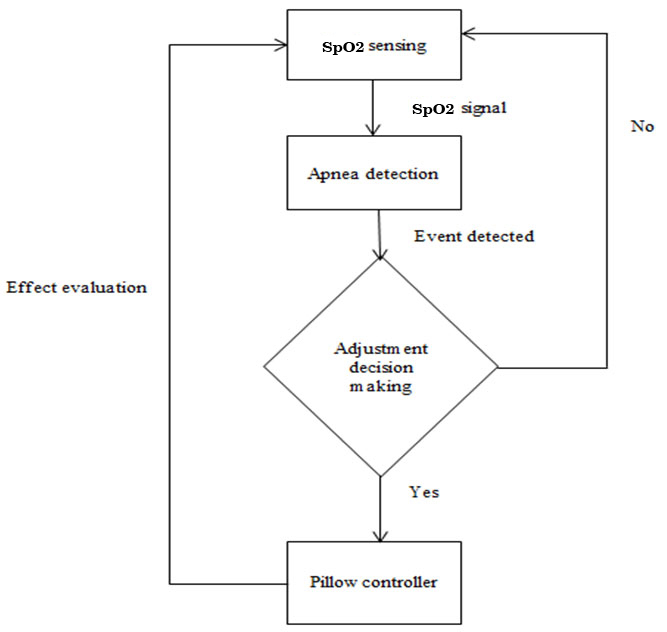
Jin Z et al., conducted experiments on 40 sleep apnea patients [7]. The results of the experiments showed that the second and fifth bladders placed under neck and head having the pressure ranges of (7000-2000, 2000-7000) were used for apnea detection.
D. Micro-electro Mechanical System (MEMS) Sensor Based Device
Sleep study involves overnight sleeping in clinical laboratory. The cost of diagnosis is expensive which makes the patients remain untreated. MEMS sensor based device is developed with an apnea detection algorithm to diagnose apnea. Due to its reduced cost, it is widely used for home sleep apnea testing. This sensor is used for device design and development, which is used to measure airflow from respiratory signal. Then the corresponding apnea event is detected by time-domain signal processing Integrated Circuits (IC). Standard 0.5- Complementary Metal-Oxide Semiconductor (CMOS) technology is used for IC chip fabrication.
Under clinical environment, sleep apnea screening and respiratory event detection is tested by this device. To detect the severity of sleep apnea, AHI are used [8].
Conclusion
The literature review explains the details of sleep apnea detection and techniques for diagnosis. The available methods describe the detection through classifiers and sensors, MEMS sensors and blood oxygen sensors are used to detect sleep apneic events, SVM and neural network classifiers are used to classify the apneic events from original events. Both respiratory and heart rate events are acquired by ECG signals, the correct apneic events are calculated from these signals. This review also included limitations such as affordability, timing and sleep apnea calculation during night-sleep. These limitations can be overviewed to improve the existing sleep apnea detection device with much more efficient features.
[1]. Peppard PE, Young T, Barnet JH, Palta M, Hagen EW, Hla KM, Increased prevalence of sleep-disordered breathing in adults American Journal of Epidemiology 2013 177(9):1006-14. [Google Scholar]
[2]. Caples SM, Garcia A, Somers VK, Sleep-disordered breathing and cardiovascular risk Sleep 2007 30(3):291-303. [Google Scholar]
[3]. The report of an American Academy of sleep medicine task forceSleep-related breathing disorders in adults: Recommendations for syndrome definition and measurement techniques in clinical research Sleep 1999 22(5):667-89. [Google Scholar]
[4]. Daniela B, Raluca V, Andrei C, Corina M, Home monitoring of sleep apnea treatment: benefits of intelligent CPAP devices Advanced Technologies for Enhanced Quality of Life, AT-EQUAL ’09 2009 :77-80. [Google Scholar]
[5]. Behbehani K, Yen FC, Burk JR, Lucas EA, Axe JR, Automatic control for airway pressure for treatment of obstructive sleep apnea IEEE Transactions on Biomedical Engineering 1995 42(10):1007-16. [Google Scholar]
[6]. Varon C, Caicedo A, Testelmans D, Buyse B, Van Huffel S, A novel algorithm for the automatic detection of sleep apnea from a single-lead ECG IEEE Transactions on Biomedical Engineering 2015 62(9):2269-78. [Google Scholar]
[7]. Jin Z, Qian Z, Yuanpeng W, Chen Q, A real-time auto-adjustable smart pillow system for sleep apnea detection and treatment Proceedings of the 12th international conference on information processing in sensor networks - IPSN ’13 2013 :179-190. [Google Scholar]
[8]. Jiayi J, Edgar S, A home sleep apnea screening device with time-domain signal processing and autonomous scoring capability IEEE Transactions on Biomedical Circuits and Systems 2015 9(1):96-104. [Google Scholar]